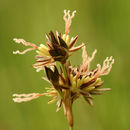Comments
provided by eFloras
This variable species has been divided into five separate taxa in the past (F. J. Hermann 1964; C. L. Hitchcock et al. 1955--1969, vol. 1), but more recently, most of the variants have not been separated (A. Cronquist et al. 1972+, vol. 6). The Oregon coastal endemic, Juncus nevadensis var. inventus L. F. Henderson) C. L. Hitchcock, is at one extreme of the variation, having only a single head, fairly dark brown tepals 3.5--4.5 mm, anthers only slightly longer than the filaments, and a distinct habitat. The J. mertensianus var. columbianus segregate, however, approaches var. inventus in number of heads, and the other characters are so highly variable in the complex, they cannot be used alone to separate this variety. Therefore, we are not recognizing any infraspecific taxa at this time.
- license
- cc-by-nc-sa-3.0
- copyright
- Missouri Botanical Garden, 4344 Shaw Boulevard, St. Louis, MO, 63110 USA
Description
provided by eFloras
Herbs, perennial, rhizomatous, 0.5--7 dm. Rhizomes 1 mm diam., not swollen. Culms erect, terete, 1.5--3 mm diam., smooth. Cataphylls 0--1, maroon or straw-colored, apex acute. Leaves: basal 1--3, cauline 1--2; auricles 1--3.2 mm, apex rounded to acute, membranaceous; blade green, laterally flattened, 1.5--31 cm x 0.5--2.2 mm. Inflorescences terminal panicles of 2--11 heads, 2--18 cm, branches erect to spreading; primary bract erect; heads 3--11-flowered, hemispheric to obpyramidal (rarely nearly spheric), 5--14 mm diam. Flowers: tepals dark brown to white, lanceolate, apex acute to acuminate, mucro subulate; outer tepals 2.8--6.2 mm; inner tepals 2.4--6 mm; stamens 6, anthers 1--2 times filament length. Capsules included to slightly exserted, chestnut brown, ellipsoid, 2.3--3.7 mm, abruptly contracted to apex, apex acute proximal to beak, valves separating at dehiscence. Seeds ellipsoid, 0.4--0.5 mm, not tailed.
- license
- cc-by-nc-sa-3.0
- copyright
- Missouri Botanical Garden, 4344 Shaw Boulevard, St. Louis, MO, 63110 USA
Distribution
provided by eFloras
Alta., Sask.; Ariz., Calif., Colo., Idaho, Mont., N.Mex., Nev., Oreg., Utah, Wash., Wyo.
- license
- cc-by-nc-sa-3.0
- copyright
- Missouri Botanical Garden, 4344 Shaw Boulevard, St. Louis, MO, 63110 USA
Flowering/Fruiting
provided by eFloras
Fruiting early summer--fall.
- license
- cc-by-nc-sa-3.0
- copyright
- Missouri Botanical Garden, 4344 Shaw Boulevard, St. Louis, MO, 63110 USA
Habitat
provided by eFloras
Wet banks along margins of streams and lakes, marshes, bogs, sloughs, and wet or boggy prairies; 0--2600m.
- license
- cc-by-nc-sa-3.0
- copyright
- Missouri Botanical Garden, 4344 Shaw Boulevard, St. Louis, MO, 63110 USA
Synonym
provided by eFloras
Juncus badius Suksdorf; J. columbianus Coville; J. mertensianuss Bongard subsp. gracilis (Engelmann) F. J. Hermann; J. mertensianus var. badius (Suksdorf) F. J. Hermann; J. mertensianus var. columbianus (Coville) F. J. Hermann; J. mertensianus var. gracilis (Engelmann) F. J. Hermann; J. mertensianus var. suksdorfii (Rydberg) F. J. Hermann; J. nevadensis var. badius (Suksdorf) C. L. Hitchcock; J. nevadensis var. columbianus (Coville) H. St. John; J. nevadensis var. inventus (L. F. Henderson) C. L. Hitchcock; J. phaeocephalus Engelmann var. gracilis Engelmann; J. suksdorfii Rydberg; J. truncatus Rydberg
- license
- cc-by-nc-sa-3.0
- copyright
- Missouri Botanical Garden, 4344 Shaw Boulevard, St. Louis, MO, 63110 USA
Juncus nevadensis
provided by wikipedia EN
Juncus nevadensis is a species of rush known by the common name Sierra rush. It is native to much of western North America from British Columbia to New Mexico, where it grows in wet areas in many habitat types. This is a rhizomatous perennial herb which varies in appearance. Its thin, smooth stems reach a maximum height between 10 and 70 centimeters. The thin green leaves may be up to 30 centimeters long. The inflorescences generally contain a number of flowers, with each flower bearing dark to very light brown tepals, six stamens with large anthers, and very long stigmas. The fruit is a shiny chestnut brown capsule.
References

- license
- cc-by-sa-3.0
- copyright
- Wikipedia authors and editors
Juncus nevadensis: Brief Summary
provided by wikipedia EN
Juncus nevadensis is a species of rush known by the common name Sierra rush. It is native to much of western North America from British Columbia to New Mexico, where it grows in wet areas in many habitat types. This is a rhizomatous perennial herb which varies in appearance. Its thin, smooth stems reach a maximum height between 10 and 70 centimeters. The thin green leaves may be up to 30 centimeters long. The inflorescences generally contain a number of flowers, with each flower bearing dark to very light brown tepals, six stamens with large anthers, and very long stigmas. The fruit is a shiny chestnut brown capsule.
- license
- cc-by-sa-3.0
- copyright
- Wikipedia authors and editors

